How does our product either meets up to or challenges these conventions?
Right from the start of our planning we agreed that we would be basing the story of our film ‘The List’ around two characters. A protagonist and a villain, partly as we were only allowed to use two minutes of footage but also as we wanted to keep it simple and not confuse the audience in the beginning.
We first tried to disturb the viewer by having the first shot of a man unconscious on the ground, this was intended to create early enigma, for example, who is he? What is he doing on the floor? Is he dead?
After this point we disrupt the linear order of events using a flashback transicion to go back in time. The idea would be that if we were to finish a whole film then we would come back to this point.
The idea behind the light switch shot is that the character is metaphorically ‘turning on’ the story.
We did try to follow the traditional three act structure briefly by establishing a set up, this shows the protagonist in his everyday life, before the incident in the first scene. We show him doing mundane tasks with extreme close ups. Also in the set up we see that the antagonist (bottom right) is preparing as well, this could be seen as a mini-disruption to the plot
Although it was hard for us to focus on anything beyond the set up as we did not want to turn this opening into a short film. At some during the rest of film, pretty soon after the start in fact, we would have a confrontation between both the protagonist and the antagonist. But as it turned out we did not have enough time to feature the disruption in the plot, we had to create tension and suspense in other ways.
One of the best ension films (in my opinion) is Vertigo by Afred Hitchcock, heres a link to its IMBD page http://www.imdb.com/title/tt0052357/ Also one should look up 'The Birds' also by Hitchcock.
Vertigo, starring James Stewart, is a work of genius as Hitchcock has the audience in the palm of his hand throughout due to the facinating nature of the story and plot. If we had been able to film the rest of our thriller then we would have certainly drawn a lot of inspiration from Hitchcock's work.
We tried to create lots of enigma in a variety of ways, one of which was through using restricted narration to frustrate the viewer. We used this throughout the film such as when both characters are preparing for different things, you hardly see the protagonist’s (left) face and you never see the antagonist’s (right) face.
.bmp)
.bmp)
We also restrict the audiences view of things by having certain shots with different depth of field, we used shallow depth of field in a few of our shots, but we used full focus shots for the most part of our film. We also used depth of field to draw the viewer’s attention from one part of the frame to the other. This was especially useful when we were making our titles.
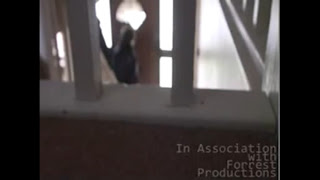.bmp)
In this Particular long shot (above), the camera is placed behind some wooden bars. This gives the immpression that someone is watching him and is peering through these bars.
Taxi driver provided us with a good example of how shallow depth of field can be used, this is the title sequence of the film so it was doubly appropriate. Although the effect was difficult to duplicate as we had to use a camera with manual focus, this meant that was much harder to shoot a static shot when you are having to use on of your hands to turn the focus on/off.
Character
As we only had two minutes, it was important for us to try and establish the key characters and their traits straight away. The protagonist after first being shown on the floor has a flashback to earlier that day. We show some of his morning ritual to show to the audience that he is intended to be a ‘normal’ guy. Through the use of gentle, everyday, props such as butter ect and through the use of setting. The setting is my house and does not bear any disturbing qualities.
A similair setting was used in Se7en, where Morgan Freeman's character is preparing for his day, but in a fashion that does not provoke anything sinister.
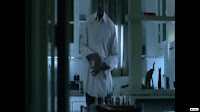.bmp) http://www.youtube.com/watch?v=Z-u3fQOOZ34
http://www.youtube.com/watch?v=Z-u3fQOOZ34The setting and props used for the antagonist on the other hand are supposed to unnerve the viewer as he is living in a ‘grimy’ location. There is an obvious use of iconography within the scene at the antagonist’s home; the large kitchen knife stained with blood is meant to present this character as dangerous. One may notice that this particular medium close up shot is almost opposite to another shot earlier in the sequence.
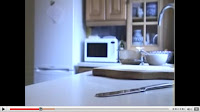.bmp)
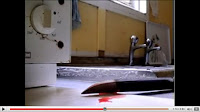.bmp)
The butter knife belonging to the protagonist on the left is supposed to suggest that he is calm and harmless, where as the large, sharp kitchen blade on the right is supposed to make it obvious to the viewer that he is dangerous and disturbed. The blood also helps to create this sense.
Even the colours of their clothes can help to put a picture of the character’s personality together, the antagonist wears dark black clothes eg gloves for the most part of the sequence. The protagonist wears normal, not to bright, but clothing that wouldn’t suggest anything sinister about this person
Lighting
It was difficult for us to use lighting to our advantage, we found that once college had finished we were rushed to get filing done before it went dark, however this wasn’t a problem when we filmed at weekends.
We used mostly high key lighting, especially for the shots within the protagonist’s house to signify his sense of transparency and innocence. Although low key lighting was used in one medium shot in which the character switches off the light and walks out the kitchen door.
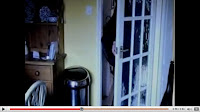.bmp)
Lighting is probably something that we should have made more use of, if we had made more use of the red head lights we may have had more option of shooting slightly later in the evening, it also would have added more quality to our product.
Camera Movement and shots
We were very particular of our camera movement. Throughout the sequence we used many close ups and extreme close ups.
This helped us to create more closed narration as we are restricting the audience’s view, and to in turn also create enigma. It was also useful for making our titles as we found that we could blend the titles into the narrative (although without disturbing the plot). We actually made it so the titles moved with the characters at certian points.
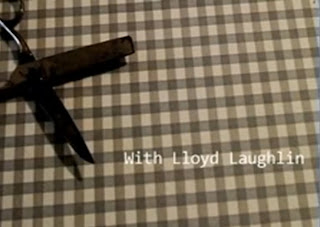.bmp)
One of my favourite shots within our film was the use of a canted camera mid-way through the film, it gave us space for some titles and it worked well in our sequence. A canted camera angle was subtle.
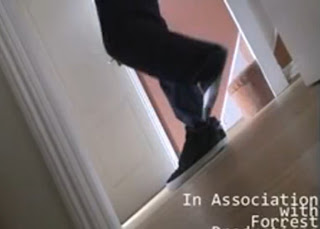.bmp)
For most of our shots the camera was static, but for some of the extreme close ups we used freehand camera. This made a slightly jolty movement which we think creates a sense of urgency about this man’s movements.
At the beginning of the sequence we had a montage of close ups one after the other. This quickly builds up some tension and also creates a sense of urgency within the film. This was inspired from the film 'Shaun of the dead', even though this is not a thriller and is indeed a horror/comedy it was still useful for this short part of our film.
http://www.youtube.com/watch?v=Qj7F7ITFSd4 This is not the actual film but it creates a very similair effect.
.bmp)
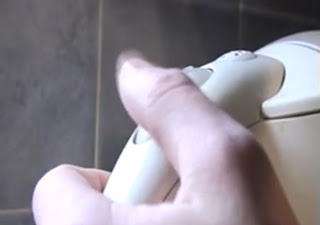.bmp)
This idea was inspired by the montage of close ups during the title sequence of the film se7en. The use of extreme close ups shows the disturbing nature of the character, it also creates closed narration through restricting the audiences view of the killer and therefore creating enigma.
You can see the full title sequence for se7en at youtube: http://www.youtube.com/watch?v=yALjuJcfg90
The final shot in our sequence is after the main title appears. After the wors 'The List' fade away a fast moving train appears at the end, this was intended to shock the audience and to simply keep them on edge.
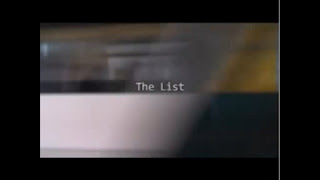.bmp)
Sound
We wanted to make use of an ambiant soundtrack or some music that would run throughout the most part of our film. We eventually decided that using this light-hearted jazzy type music would be appropriate. We thought that having the tones from the music contradict the ones from the images would provoke curiosity from the audience. The music seems to fit at the beginning of the extract as the protagonist isn’t doing anything sinister or out of the ordinary, it makes it seem as if the protagonist is oblivious to any possible danger.
A similar technique was used at the beginning of the film ‘Misery’ in which the protagonist is listening to Moetown music whilst driving perilously on the side of a mountain.
www.youtube.com/watch?v=Cgqu2w3Ore4
We also faded out the music once the setting had changed so that it was only very faint in the background, we used this to help establish a different place in the film.
We also faded out the music once the setting had changed so that it was only very faint in the background, we used this to help establish a different place in the film.
How does your media product represent particular social groups?
In truth it is hard to establish any kind of social group at first glance at our product as we see so little of the character’s faces. The main focus is on the actions in the thriller opening.
But that does not say, however that this film would not have gone onto to represent particular social groups, in particular a slightly younger group of people, (possibly aged around early twenties, late teens) this group is represented through the items of the protagonist. He holds a rucksack; this is an obvious symbol of a student or a young person off to work.
.bmp)
We used this social group because we knew that it would relate better to our class audience. It is also highlighting the possible vulnerability that people sometimes associate with young people wondering on their own. So this film is not just aimed at young people but also an older audience as well as this will relate to parents who have children who live alone. Obviously we are not suggesting that parents should not let their children leave the house but it would hopefully unsettle any adults watching the entire film to create the tension required to make it a climactic thriller.
Programs like ‘Skins’ have been building up stereotypes and different characters of young people in the UK, we would hopefully play off this generation for our film. If we were to complete the whole film, the representation of woman would be modern. This is because that the traditional representation is now inaccurate and doesn’t really apply to society today. Also modern woman in TV or films are more complex characters to show and are therefore more interesting. A modern woman may be seen as strong, independent and self-reliant. Whereas the traditional representation would be the exact opposite of all of those features. Although it is hard to back this speculation with evidence because we have only featured two characters in the opening to our thriller.
Although with the music we have used, it is hard to relate this to a young adult audience. The slightly jazzy piano music would perhaps attract a more matured veiwer, but this film is full of contrasts. The music may even link directly to either of the two characters; it could reflect the protagonist’s personality of being calm, couls suggest to the veiwer that he is too careless.
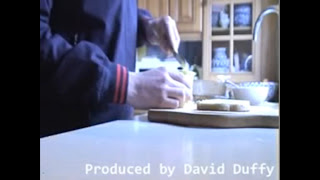.bmp)
The protagonist’s clothes are not supposed to provoke anything in particular as he is wearing normal clothing (see above), this would hopefully make the audience accept him as a normal person. This makes the situation all the more sinister as one would have to ask what does this man have to do with a dangerous and psychotic person in the other setting of the thriller. But despite attempting to present this man as young, we also wanted to create some form of suspicion as we used so many extreme close up shots to try and make the audience feel untrustworthy of this person.
.bmp)
At the same time the protagonist character would challenge the normal common ideas of the young British male stereotype. Also, we planned to use women characters in a way that would not show them as victims, but counterparts to the main protagonist. It has become common for female characters to play just victims where their binary opposite is masculine.
So overall we are trying not to conform to the common thriller conventions. We see this usage of the stereotypical women victim character in many of Hitchcock’s works such as Vertigo where Kim Novak’s character is vulnerable and requires the male character played by James Stewart to protect her. Hitchcock constantly used women, particularly blonde, to play similar roles. But this is not to say however that his characters were so traditionally based.
(James Stewart and Kim Novak in Vertigo) 
For the antagonist, it is hard to relate this man to a particular social group; the film focuses more on the social groups that he targets for victims.
What kind of Media Institution might distribute your Media product and why?
We would hope that our film would fit into the category of a blockbuster film. By this we mean that we want to distribute the film via the usage of major companies for instance New Line Cinema.
For the antagonist, it is hard to relate this man to a particular social group; the film focuses more on the social groups that he targets for victims.
What kind of Media Institution might distribute your Media product and why?
We would hope that our film would fit into the category of a blockbuster film. By this we mean that we want to distribute the film via the usage of major companies for instance New Line Cinema.
The company that we would most like to go through would be Paramount Pictures. We would chose this company because they have an excellent history of producing many excellent films and in particular thriller ones. Perhaps the most famous director of all time, Alfred Hitchcock, had his film ‘Vertigo’ was first distributed through Paramount. They are one of the world’s leading distributers in film and their recent profits have been on the rise. They also have a great online film community which could be used to tell people of our film through the use of forums ect.
We would of course give Paramount licensing rights in order to help distribute the film as much people as possible. But there are certain measure that we could take ourselves for instance we could use Facebook, Twitter and Myspace fairly cheaply
Another film which Paramount distribute is ‘Shutter Island’ which is a recent thriller starring Leonardo de Caprio, the themes and tones created in this film reflect the aims of ours.
But most importantly is that they have links and influence across the entire film industry, having business links with the likes of DreamWorks ect, so they would be able to get our film the most publicity and also get it across the entire industry.
We would want to take full advantage of the newest innovations in distribution, such as the usage of digital distribution; Paramount even has their own Digital Distribution section of their website.
However we may also look to do a deal with a major video games distributer such as Microsoft and Sony. We would not preferably to a deal with Nintendo because they have a too younger audience. We would hopefully be able to post small clips and trailers of our film onto the main pages of people’s games consoles. I know this to be effective as we can see this with the ‘Lynx Twist’ short films on the Xbox 360.
Obviously we would want to put our prints into as many big cinemas across the UK, so that this would be a high concept film, if we were to get the help of Paramount Pictures then we could easily.
We hopefully use the obvious routes of advertising to remind every person of our film. These would include TV trailers, Internet ads (on the side of certain websites), also posters and billboards in dense cities where there is a big film community. And also we would hope to exploit the ‘Videos on Demand’, such as Sky movies once the film is out. But of course these costs would have to be met by Paramount Pictures.
Who would be the audience for your media product?
There would be no particular gender target audience for our film, despite the main characters being men. Our film would also be rated a 15 as it will contain content that is intended to disturb the veiwer but there isn’t a big use of graphical content and gore. We aim to be more subtle about our film.
Even though the age certificate would be 15, the target audience would be anything from 15 + as when it comes to thrillers; they have a much broader market appeal then say a period drama like Pride and Prejudice. However we would expect that a slightly younger audience may be more drawn to it because of the young age of the characters on screen.
I personally asked many people who watched our film, and enjoyed it, as to what was their favourite thriller at the moment. 70% of those people said ‘Shutter Island’.
When i asked the same people when given a choice of: Vertigo, Memento, Se7en or The Birds – 60% of them said that they preferred either Se7en or Memento.
These people are students from my college and it is clear that they prefer the more modern films such as ‘Memento’ rather than the old classics such as ‘Vertigo’. This is good because these are the kind of films that we are trying to emulate.
What have you learnt about technologies from the process of constructing this product?
List:
HDV 1080i r mini DV
Camera tripod
Red-Head Light
Light tripod
Also Mac computers with:
Final cut pro
Imovie HD
Garage Band
We learnt vast amounts as a group about the various equipment that we used. We were very lucky to be able to use the HD cameras available; this allowed us to tamper with the depth of field far easier because of the option of a manual zoom. The quality of the camera was also outstanding, especially when compared with the smaller cameras. Also the sound that was picked up was of much higher quality because of the very sensitive mike on the camera.
We made the first usage of the red head lights for filming our sequence and it certainly helped to duplicate the light of day during the evening. This was especially useful as we filmed in the winter, where it got dark very quickly after college so we had limited time to film; the light meant that we could film for longer without the darkness having an effect.
In terms of safety, we had to be far more aware of the potential hazards as we had more equipment (and more expensive equipment for that matter) to use. We put sandbags over the tripod of the light so it would not tip, covered wires in duck tape and used gloves for when handling the light as it got hot after sustained usage.
Also, we have learnt about blogging through this media task. None of us within the group had ever used or made a blog before and it was an enjoyable new way to do coursework. It meant that we could get more creative. Although overall I do not believe that the blog has made this work any easier, in fact it has made it more complicated and strenuous. This is because the writing tool for the blog is useless as it is very annoying just to move a picture around. Not only that but the whole structure and spacing of an essay can randomly fall apart once you log off.
We all learnt bags of stuff about the usage of new software, especially Final Cut Pro and Garage Band. We used this for the most part of our editing and it was especially useful for creating our titles throughout the film. Final cut is more complicated and detailed then imovie, so this allowed us to use more complex methods to create an overall better film.
How did you attract your audience?
I believe that to make a modern successful thriller it has to be pact with enigma provoking shots. We see this in such films as Se7en, especially in the title sequence.
The veiwer has to ask questions at the very beginning of the film as to why there is a random man on the floor. We think that by using many extreme close ups we have limited the view of the audience and have created closed rather that open narration. We can see this in our thriller by watching the montage of close ups whilst the protagonist is in the kitchen, preparing for his day.
We tried not to use violence in the opening sequence because otherwise the veiwer would have thought that this violence would re-occur throughout the whole film. Btu we did, however, try to connote the previous and future usages of violence through the use of iconography. By placing knives in the camera shot stained with blood, the connotations to the veiwer are obvious. By not actually showing the knife being used, it will almost tease the veiwer.
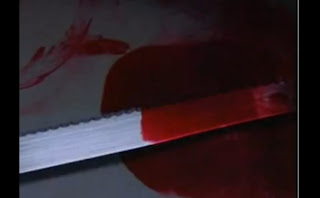.bmp)
In terms of story there is little to give away from the opening 2 minutes. However, the very first shot is very provocative as there is a random man on the ground. By using a flashback here we frustrate the veiwer by going back in time and not explaining why he is there straight away. I think that twists like these will attract a younger audience, interested in seeing something different.
We also attracted people by using depth of field. This proved to be a great way of creating closed narration by blurring and therefore restricting the audience’s view through. We continually used shallow depth of field.
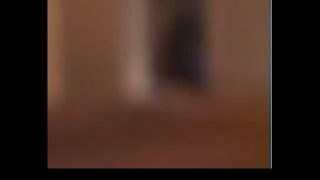.bmp)
The music for our film is curious for the audience, after seeing the disturbing opening scene and then the flashback, the audience will be worried when they see that the protagonist is playing jazzy, causal music and this suggests that he is unaware of his impending danger.
Assessing our effort and work
I believe that I put enough effort into our film to be recognised as a major contributor. I turned up to every filming and editing session and was also a contributor into the storyboard and the original ideas behind the film. However I could defiantly have been more organised throughout the process, despite always turning up I could of perhaps made more effort to organise filming and editing sessions. I also made mistakes when filming eg, forgetting the tape (although we borrowed some else’s) and actually forgetting to pick up the camera at the end of the day. However I am not a total idiot and these mistakes were not made more than once.
The main fault behind my organisational skills was that I didn’t recognise early enough when something went wrong with our blog. For example we were given the tasks of analysing 5 title sequences from other random thrillers, I completed the task but for some reason the blog failed to publish the posts. I only realised this until a day before the final deadline for the whole blog so it was frustrating knowing that this problem could have been avoided had I done a more thorough check on the blog posts earlier.
Jamie gave great input the whole way through the process, whether it be editing or filming. He was also especially good for the storyboard designing process. It was always going to be difficult to meet up outside of college because he lives in a different village, as does Chris. But this was rarely an evident problem as a know Jamie very well and can easily contact him at any time.
The same can be said for Chris as he too lives in a different village but still made the effort to meet up and stay in contact. Chris also made very creative inputs for the narrative of the film which helped to improve the quality. He also helped us to drop certain parts of the film that weren’t needed which helped us keep to our 2 minute time limit. At certain points during the whole process, Chris sometimes missed sessions due to illness, but he did make up for the absences by keeping track of what me and Jamie had done. These absences were also rare.
Peer Evaluations:
Good:
- Looks like a thriller
- Lighting is very good, separated each character well
- Confuses veiwer (in a good way)
- Knife in the sink especially effective shot
- Good use of iconography
- Music contrasts well with the images on screen
- Good titles and effects
- Good use of depth of field
- Enigma as to who the characters are
- identities not revealed – good enigma
- Good Mise en Scene for second character
- Music volume changes to show different settings
Bad:
- Music did not work well
- Shot of protagonist leaving, lighting was too bright
- Music made it seem like a Rom Com
- could be more effective with non-diegetic sound
What do you feel you have learned in the progression from the preliminary to the final product?
I think that we have made substantial progress in terms of quality from our old preliminary task to this one. I think that one of the main factors in this has been that we have been using better equipment and technology, as for the first attempt we only used Imovie. This meant that there was very basic use of continuity editing, however we did what we were asked to do in the preliminary tasks and our knowledge of final cut pro was next to nothing. Also we had a better quality camera for this thriller and we also actually made use of the red head lights.
Small details such as mistakes with the sound eg, we had some people talking in the background in one of them, made our preliminary task look shabby and rough around the edges. We have made a much better use of continuity editing in ‘The List’ as we have led the audience through far smoother than before. With the use of transitions such as fades the film seems to just to flow much better. However if it had not been for our preliminary task we probably would not have used such things like a parallel editing which we made a lot of use of in ‘The List’.
I think that we have also exploited the possibility of using depth of field in this thriller. And our overall use of shots to match the characters and to close off narration has been better. As it is an opening sequence we tried to use shots that would simply draw people, so we used very little medium shots so as to not seem mundane and we used many extreme close ups to restrict the veiwer and just to give a more dynamic approach the film.
We have also been more subtle about how we try to create character through props and mise enscene. For starts we avoided using hooded tops as that is a cliche and a cheap way to try and create a sinister antagonist. We kept facial shots on our opening to a minimum and included no dialogue, this isn't anything new as we never wanted to expose our poor acting capabilities.
I think that due to the better continuity editing we have led the audience smoothely though our film, especially with the use of parallel editing between the two characters. Even though it would have been good to show our knowledge of the 180 degrees rule, but that would mean using dialogue which we chose not to use.
I think that overall we have become more complex in the way that we think about creating thrillers, we used films such as 'Memento' to help give us ideas about how to construct a complicated narrative. With the help of better equipment and software we have made an overall better film in terms of camera work, mise en scene and narrative to make an effective thriller opening.


.bmp)
.bmp)
.bmp)
.bmp)

.bmp)














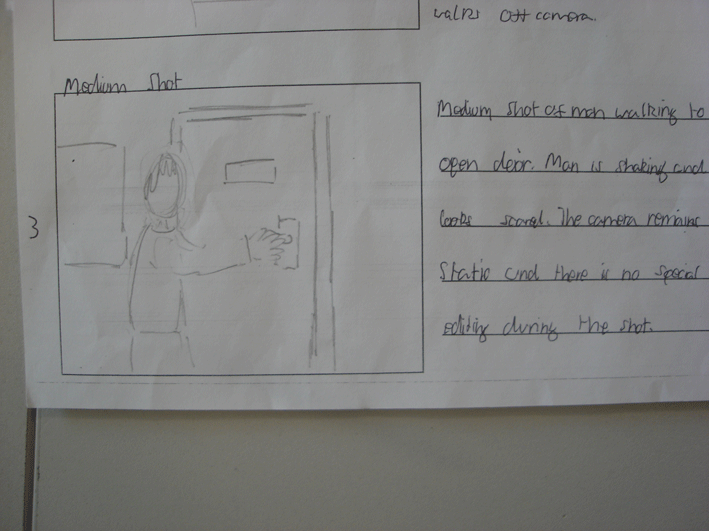















No comments:
Post a Comment